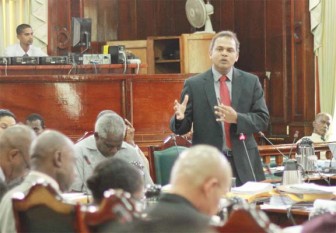Culture Minister Dr Frank Anthony yesterday defended government’s decision to erect the 1823 Demerara Slave Rebellion monument along Carifesta Avenue, saying that the “prominent” site was chosen after an invitation for the public’s input yielded no responses.
“In the end, because we didn’t have any persons coming forward to say this is where we want it to be… The committee made a decision and… started construction of the monument at Vlissingen [Road] and Carifesta,” Anthony told the National Assembly yesterday.
He was at the time responding to questions from APNU MPs Christopher Jones and Volda Lawrence about the change in location from the Independence Park (Parade Ground), where a sod turning was witnessed by members of the PPP/C government and diplomatic corps back in 2008. The opposition MPs also asked the minister to provide the name of the persons or organisations that were consulted before the decision was made to site the monument at Carifesta Avenue.
The move to erect the monument has sparked protests by groups, including members of the African Cultural and Development Association (ACDA), the Manumitted African Descendants Organisation, and the Pan African Movement, who say it should to be placed at Parade Ground, the site where some of those who participated in the insurrection were killed.
In March, the ministry had invited submissions from the public on the location of the monument site. It had said then said that after wide consultations, areas between Mahaica and Georgetown were short-listed based on criteria such as ambience, emotional and physical connection to the rebellion, (and) adequate land space, with a view for a future park, accessibility, vehicle parking and public view. The sites being considered then were Independence Park (Parade Ground) in Middle Street, Georgetown; an area at Montrose, East Coast Demerara; and an area north of the public road at Melanie Damishana, East Coast Demerara.

Anthony said that no one or any organisation responded to the request and as a result a committee set up by the ministry chose the location it felt best matched the criteria. “Out last press release was in March of this year and we set a deadline. We received no submissions,” he said.
Anthony referred to other monuments in Guyana, saying that some of the most recognised ones are not at the actual location of the events they are commemorating. He cited the 1763 slave revolt in Berbice. “We didn’t we have a monument there, we erected a monument right here in Georgetown,” he said, while adding that the statue of Damon is at Anna Regina, although the site of the protest he led was at La Belle Alliance.
“It is very important for our history… 13,000 slaves rose up from 37 different plantations … it is very important that we put it in a place that is very convenient to remember the occasion because this is one of the major rebellions in our country … and we think that by erecting this monument at a prominent spot is to remind Guyanese of this very important event in our history,” Anthony added of the Carifesta Avenue site.
During one of the protests against the current site, Barrington Braithwaite, a member of the ACDA, called the decision “an arbitrary” one by the minister, while noting that the organisation would not recognise the monument if it isn’t erected at the Parade Ground. “We will ask the people in Parliament to address the minister’s competence of managing his office,” Braithwaite said, while adding that the ministry never invited ACDA or any African-Guyanese organisations to discuss the building of the monument.





